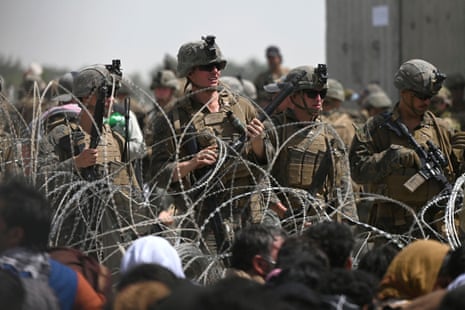U.S. Withdrawal from Afghanistan: A Cascade of Challenges for Pakistan

Abrupt U.S. withdrawal from Afghanistan in August 2021, after two decades of conflict, has left Pakistan grappling with a complex web of security, diplomatic, and humanitarian challenges. The hasty end to, two decades long U.S.-led occupation, has reshaped the regional landscape, with Pakistan alone bearing the brunt of fallout. The consequences – ranging from intensified terrorist activities to strained Pak-Afghan relations, and humanitarian crises – are testing Pakistan’s resilience and strategic calculus.
An Untrustworthy Alliance in a Costly War? In the wake of the September 11, 2001, terrorist attacks, the U.S., alongside allies from 45 countries, launched Operation Enduring Freedom to dismantle Al-Qaeda and oust the Taliban from power in Afghanistan. Pakistan, sharing a 2,600-kilometer porous border with Afghanistan, was thrust into the conflict with little – perhaps no choice. Former U.S. President George W. Bush’s stark ultimatum – “You are either with us or against us” – compelling Pakistan to align with the U.S.-led coalition, providing logistical support, intelligence, and access to its airspace. However, the partnership was fraught with tension and mistrust. U.S. officials, including Admiral Mike Mullen, former Chairman of the Joint Chiefs of Staff, frequently expressed dissatisfaction with Pakistan’s efforts, accusing it of playing a “double game”, blaming Pakistan of harboring Afghan Taliban elements. Pakistan, on the other hand, faced immense domestic costs, including over 80,000 casualties (military and civilian) and economic losses estimated at $150 billion over two decades, as it battled militancy within its borders while supporting the U.S. war effort. Pakistan Army’s first ever deployment in the Western Tribal areas, along the Afghan border, was perceived as a betrayal and an intrusion, violating local cultural norms and historical precedents. The gravity of Pakistan’s precarious situation becomes evident when considering that the very Taliban – nurtured, trained, and armed by Pakistan with the support of the U.S. and other Western countries – now posed a direct threat to its stability. Here, one is reminded of Henry Kissinger’s quote “It may be dangerous to be America’s enemy, but to be America’s friend is fatal.”
The U.S. Exit and Its Fallout: After 20 years of fighting, the U.S. suffered approximately 2,500 military fatalities and spent over $ 2 trillion in Afghanistan. The withdrawal, completed on August 30, 2021, pursuant to the February 2020 Doha Agreement between the U.S. and the Taliban, was marred by disarray. The U.S. left behind an arsenal of military equipment, including 600,000 Small Arms, 75,000 combat vehicles, 200 aircraft, and millions of rounds of ammunition, much of which fell into the hands of the Afghan Taliban. The Taliban, having fought a relentless insurgency, swiftly seized Kabul, toppling the U.S.-backed government of Ashraf Ghani. They reinstated a strict interpretation of Sharia law, reminiscent of their pre-2001 regime, rolling back gains in women’s rights and education. The power vacuum and abandoned weaponry have fueled regional instability, with Pakistan facing the most immediate consequences. Many in Pakistan believe that, true to its historical pattern, the U.S. has once again abandoned Pakistan after exploiting its support in a war that Pakistan had nothing to do with. Leaving Pakistan in a perilous state, surrounded by known and unknown adversaries – an enemy that the U.S. and its allies could not defeat after two decades of conflict.
Resurgence of TTP and BLA: The Tehrik-e-Taliban Pakistan (TTP), a terrorist group aiming to overthrow the Pakistani government, has flaunted a deadly resurgence since the U.S. withdrawal. Emboldened by the Afghan Taliban’s victory and armed with U.S.-made weapons, the TTP intensified its attacks, particularly in Pakistan’s Khyber Pakhtunkhwa and Balochistan provinces. In 2022 alone, the TTP claimed responsibility for 26 attacks, including a July bombing targeting Chinese workers. Following the Afghan Taliban’s takeover of Kabul, they released hundreds of TTP prisoners, including senior leaders like Maulvi Faqir Mohammad and Mufti Khalid Bulti, from Afghan prisons, such as Bagram and Pul-e-Charkhi. This bolstered the TTP’s resurgence. Similarly, Pakistani government released hundreds of TTP prisoners, between November 2021 and early 2022 as a goodwill gesture to support peace negotiations facilitated by the Afghan Taliban. These releases, aimed to reintegrate TTP members into mainstream society failed to secure a lasting ceasefire, the TTP rather resumed attacks with more vigor by late 2021.
The Balochistan Liberation Army (BLA), a separatist group seeking independence for Balochistan, also capitalized on the abandoned U.S. arsenal. BLA militants have been observed using advanced weaponry, including M16 rifles and night-vision goggles, in attacks on Pakistani security forces and on Chinese-funded infrastructure projects under the China-Pakistan Economic Corridor (CPEC). The group’s rejuvenation has compounded Pakistan’s security challenges, with a significant spike in terrorist attacks reported since the Taliban’s takeover in Afghanistan.
Strained Pak-Afghan Relations: The U.S. withdrawal has severely strained Pakistan’s relations with Afghanistan. Pakistan accuses the Afghan Taliban of abetting TTP and BLA activities, pointing to cross-border attacks orchestrated from Afghan soil. The Taliban-led Interim Afghan Government (IAG), in turn, has accused Pakistan of violating its territorial integrity through airstrikes targeting TTP hideouts. The IAG’s failure to curb terrorist groups, including TTP, Al-Qaeda, and the Islamic State Khorasan Province (ISKP), violates the Doha Agreement, which stipulated that: Afghanistan would not serve as a base for terrorism against other countries. Efforts to mediate, including Taliban-hosted talks between Pakistan and the TTP in Kabul, have yielded no progress, with the Afghan Taliban showing little willingness to act against their ideological allies. Recent border clashes between the two countries were perhaps the only precedent in Pak-Afghan history, where both sides went into offensive against each other. This came at a time when Afghan Foreign Minister was on an official visit to India. China and Qatar’s recent mediation efforts didn’t yield any visible outcomes either. This has deepened mistrust, further souring bilateral ties.
Deportation of Afghan Refugees: Pakistan, host to over 3 million Afghan refugees since the Soviet invasion of 1979, has faced a new humanitarian crisis. Fearing that TTP militants could infiltrate under the guise of refugees, Pakistan intensified its crackdown on undocumented Afghans, deporting over one million Afghans since 2021. This has sparked tensions with the IAG, which has criticized Pakistan’s actions as inhumane. The deportation has also fueled domestic unrest, with groups like the Pashtun Tahafuz Movement (PTM) accusing the government of targeting ethnic Pashtuns, further complicating Pakistan’s internal politics.
Trade and Diplomatic Ties in Tatters: For over 50 years, Pakistan has allowed Afghanistan duty-free access to its land routes and ports under the 1965 Afghanistan-Pakistan Transit Trade Agreement (APTTA), revised in 2010, facilitating Afghan trade. Trade and diplomatic relations between Pakistan and Afghanistan have deteriorated sharply. Bilateral trade, once valued at $2.5 billion annually, has plummeted due to border closures and heightened tensions. The Torkham and Chaman border crossings, vital for trade, have been repeatedly shut following skirmishes. However, this has led to significant losses from smuggling, costing Pakistan billions in revenue and distorting markets. With the APTTA expired since 2021 and recent talks yielding minimal progress, Pakistan should impose targeted tariffs on Afghan transit goods to reclaim economic sovereignty and address these imbalances.
Pakistan’s diplomatic efforts to advocate for an inclusive Afghan government representing all ethnic groups have been largely disregarded by the Taliban, who continue to uphold a predominantly Pashtun-led regime since their 2021 takeover. The lack of international recognition for the Islamic Emirate of Afghanistan (IEA) has further hindered Pakistan’s attempts to foster constructive engagement with Kabul. Meanwhile, Qatar and China’s recent initiatives to mediate and improve Pak-Afghan relations have shown limited progress, with no significant or tangible outcomes achieved to date.
Pakistan’s Missteps in the War on Terror: Pakistan’s approach to combating terrorism has drawn criticism for its inconsistencies. The government’s truces with the TTP, particularly in 2021, allowed militants to regroup and rearm. The release of high-profile Taliban prisoners, including those who later joined the TTP, further exacerbated the threat. Pakistan’s over-reliance on military operations, though with reduced civilian fatalities, neglected other instruments of national power, such as diplomacy, economic development, and de-radicalization programs. These missteps have left Pakistan vulnerable to the current wave of militancy.
The Indian Factor: Chanakya Kautilya’s timeless dictum from The Arthashastra – “Every neighboring state is an enemy, and the enemy’s enemy is a friend” – drives India’s cunning foreign policy. India has relentlessly worked for decades to sabotage Pakistan-Afghanistan relations, exploiting regional rivalries to secure its own dominance. The Taliban, now ruling Afghanistan, conveniently ignore that India backed the U.S. and its puppet regimes under Hamid Karzai and Ashraf Ghani to suppress them. While Pakistan was blamed to have soft corner for Afghan Taliban. If India had any genuine concern for Afghans, it would have opened its borders to Afghan refugees stranded in Pakistan, offered thousands of scholarships to Afghan youth, or even trained Taliban fighters at the Indian Military Academy (IMA), converting them into organized and disciplined army. In October 2025, Iran announced plans to issue 200,000 work visas to Afghan nationals, aiming to regulate labor migration, curb illegal crossings, and strengthen bilateral ties. India, on the contrary fuels chaos by supporting terrorist groups like the TTP and the BLA, destabilizing the region for its own gain. The Islamic Emirate of Afghanistan must wake up to the reality that Pakistan has been, and will remain, the steadfast ally of the Afghan people, unlike India’s duplicitous agenda.
A Path Forward: To navigate this crisis, Pakistan should adopt a comprehensive, multifaceted strategy. Primarily, it must engage with the U.S., emphasizing the U.S.’s obligations to sustain support for Pakistan’s counterterrorism efforts – efforts Pakistan undertook largely at the U.S.’s behest. Second, it should strengthen border security, completing the fencing of the Pak-Afghan border to curb illicit arms, and militant flows. Third, diplomatic engagement with the IAG, backed by regional powers like China and Russia, is essential to pressure the Taliban to act against TTP and other terrorist groups. Fourth, Pakistan must balance its refugee policy, addressing security concerns while upholding humanitarian obligations. Fifth, a comprehensive counterterrorism strategy—integrating military, economic, and social measures – is critical to addressing the root causes of militancy. Finally, the world – especially the U.S. – must share burden of Afghan refugees, and help Pakistan in smooth repatriation of these back to Afghanistan. The United Nations High Commissioner for Refugees (UNHCR) should resume its program in Pakistan for support and repatriation of Afghan refugees.
The U.S. withdrawal from Afghanistan has left Pakistan at a crossroads. As former Pakistani ambassador Touqir Hussain aptly stated, “Pakistan might think it would be a good policy to stay away from the Afghan conflict, but the Afghan conflict will not stay away from Pakistan.” Islamabad’s ability to adapt to this new reality will determine its security and stability in the years ahead.


